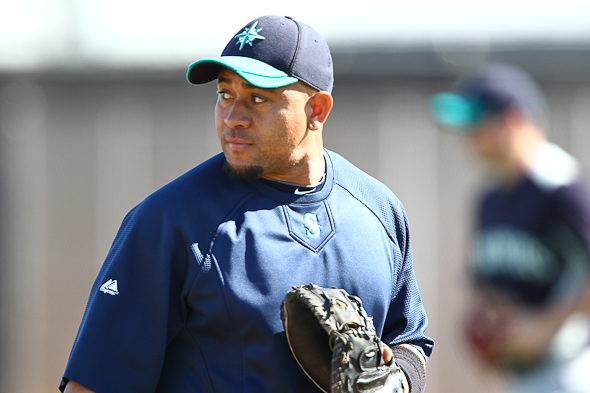
PEORIA, AZ It was back in 1986 that Carl Willis, then an aspiring Major League pitcher, learned everything he had to know about what makes a good catcher.
“I was a Rule 5 pitcher in spring training with the Angels, and I got a chance to throw to Bob Boone, Willis told sportspressnw.com. “Hed look at the hitters feet, then his hands, then his shoulders.
“Once hed done that, hed get down and give a sign. And he did it with such confidence that there was no way as a pitcher that you couldnt be confident, too.
Willis was never able to throw to Boone in a regular season game, the Angels opting to send him back to the club from which hed come, Cincinnati, before the season began. But for two decades now Seattle Mariner pitching coach Willis has made it a point to appreciate what competent catchers mean to young pitchers.
The catcher du jour now in Seattles spring camp is Miguel Olivo, who is back with the club as a mature, veteran 32-year-old catcher. When Olivo was first in Seattle in 2004 he was 25 and just learning that being a good Major League catcher was about more than hitting a few home runs, and blocking pitches in the dirt and challenging opposing base runners.
Its the Mariners sincere hope that Olivo can give the club what it sorely lacked in 2010 when Rob Johnson, then Adam Moore, did the bulk of the catching. Experience was missing, as was the knowledge that only comes from studying the game while going through the trial-and-error phase that all young catchers go through.
Olivo signed a two-year deal to come back to the Mariners, and a portion of whatever success the Mariner pitchers have in 2011 will be due to how well Olivo does or doesnt do in the job being asked of him.
“I think Im the same Miguel, Olivo said when asked about the need to step up and take major responsibility for an entire staff of big league pitchers. “But I think Ive come a long way as a catcher. Ive grown up in the way I call a game, and I want to help these pitchers be as good as they can be.
Toward that end, Olivo and Willis will have to work as a unit. Its up to Willis to get the basic daily plan of attack together, but once the game starts, Olivo has to be the one who sees that the job gets done.
With rare exceptions, he will call the pitches, the pitchouts and the pickoffs. He will urge his pitchers to keep on tempo, pace being a major part of success. And he will do much of the talking on the mound.
“I think its a real important role, and Im ready to do it, Olivo said. “Basically, my job behind the plate is very simple. Its to get the pitcher to throw the right pitch at the right time in the right location.
“To do that, you have to know the hitters, you have to study the scouting reports and you have to know your pitchers.
Its one thing to know the Cy Young Award winner, Felix Hernandez. Such is the quality of his stuff that Hernandez probably will have success no matter who the catcher is.
Its the handling of the other dozen or so pitchers that can prove to be challenging.
“Take Felix and (fellow Mariner starter) Doug Fister, Willis said. “About the only thing they have in common is that theyre right handed. Other than that, nothing of what they do is the same.
Hernandez throws hard with sinking movement on his fastball, has a nasty curve and likes to get hitters to swing at pitches in the dirt. Hitters swing and miss a lot against him. Fister relies on placement of his pitches, the fastball primarily, but also an improving curve and a nice changeup. Fister pitches to contact, and when hes going good, he tends to give up mostly ground balls.
“You cant call the same pitches with different guys, Olivo said. “Ive worked with Felix in the past, so I know what to expect there. But the rest of the pitching staff has changed since I was here last, and in spring training Im going to be learning what is best for each one of them.
Willis said that when he and manager Eric Wedge were working together in Cleveland, they learned to be patient with catchers developing the needed skills for the job. Victor Martinez came up as a big strong hitter, but he was unpolished in the extreme behind the plate.
“Victor really had to grow into it, Willis said. “He had to learn each of the pitchers strengths, and he had to learn each of the hitters, too. He had to learn that not all hitters could be attacked the way other pitchers attacked him.
“Miguels a lot further along than Victor was early on. Hes certainly near the top of the curve in terms of energy output. Even when hes catching batting practice, you can hear in the way he talks that hes reaching out to the pitcher.
That process is going to have to comprise a great deal of the spring if Seattles pitching is going to hold together in the summer.
Twitter: @JHickey3
